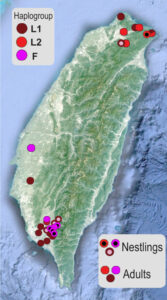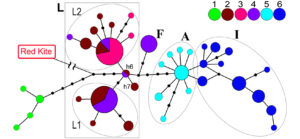Third International Scientific and Practical Conference “Eagles of the Palearctic: Study and Conservation”
Raptors Conservation. Suppl. 2. Proceedings of Conferences
GENETIC RELATIONSHIPS IN BLACK KITES (MILVUS MIGRANS) FROM NORTHEAST ASIA, JAPAN, TAIWAN, INDIA AND AUSTRALIA: DOES M.M. FORMOSANUS EXIST?
Andreyenkov O.V. (Institute of Molecular and Cellular Biology SB RAS, Novosibirsk, Russia)
Hong Sh-Y. (Institute of Wildlife Conservation, College of Veterinary Medicine National Pingtung University of Science and Technology; Raptor Research Group of Taiwan, Taiwan)
Lin H-Sh. (Institute of Wildlife Conservation, College of Veterinary Medicine, National Pingtung University of Science and Technology; Raptor Research Group of Taiwan; Graduate Institute of Bioresources, National Pingtung University of Science and Technology, Taiwan)
Karyakin I.V. (Russian Raptor Research and Conservation Network; Sibecocenter LLC, Novosibirsk, Russia)
Iwami Y. (Yamashina Institute for Ornithology, Abiko, Japan)
Kirillin R.A. (Institute for Biological Problems of Cryolithozone SB RAS, Yakutsk, Russia)
Literák I. (Faculty of Veterinary Hygiene and Ecology, University of Veterinary Sciences Brno, Czech Republic)
Contact:
Natalya Andreyenkova anata@mcb.nsc.ru
Shiao-Yu Hong laughrain@gmail.com
Hui-Shan Lin blackkite@gmail.com
Igor Karyakin ikar_research@mail.ru
Yasuko Iwami iwami@yamashina.or.jp
Ruslan Kirillin ruslan.kirillin@gmail.com
Ivan Literák LiterakI@VFU.cz
Recommended citation: Andreyenkova N.G, Hong Sh-Y, Lin H-Sh, Karyakin I.V., Iwami Y., Kirillin R.A., Literák I. Генетическое родство популяций чёрного коршуна (Milvus migrans) from Northeast Asia, Japan, Taiwan, India and Australia: Does M. m. formosanus exist? – Raptors Conservation. 2023. S2: 335–339. DOI: 10.19074/1814-8654-2023-2-335-339 URL: http://rrrcn.ru/en/archives/35126
The range of the Black Kite (Milvus migrans) includes vast territories in Eurasia, Africa and Australia. This raptor demonstrates unique ecological plasticity, inhabiting a variety of biotopes and readily taking the advantages of living close to humans.
According to various sources, the Black Kite has from five to seven subspecies. Two of them inhabit in the Palearctic: the western part is occupied by the European Black Kite (M. m. migrans), and the eastern by the Black-Eared Kite (M. m. lineatus). The islands of Japan are also inhabited by M. m. lineatus, however, this population is rather isolated from the mainland and may be genetically different. The routes of seasonal movements of these birds do not extend beyond the Japanese islands, while all the mainland kites of the eastern Palearctic make long-distance migrations from north to south and back. India and Indochina are inhabited by the Indo-Malayan subspecies (M. m. govinda), while Australia and adjacent islands are populated by (M. m. affinis). In addition, in the eastern part of mainland China, in Taiwan and Hainan, М. m. formosanus resembling the smaller form of M. m. lineatuswas described at the beginning of the 20th century. Since then, this subspecies has been officially included in all taxonomic lists, but it has never been specifically studied. Since the first description of М. m. formosanus , the populations of the Black kite, like many other birds, have experienced a sharp decline in these areas due to intensive use of pesticides in agriculture. Currently, there is no data confirming the existence of М. m. formosanusas an independent genetic branch of the Black Kite.
Previously, we found that Black Kite subspecies of Europe, North Asia, and India are genetically distinct and have their own haplogroups of the mitochondrial cytochrome B (CytB) gene. However, the low variability of the gene made it impossible to detect differences between the populations of India and Australia. Deciding to investigate the eastern subspecies in more detail, we analyzed the CytB and ND2 mitochondrial genes in the Black Kite populations of northeast Asia, India, Taiwan, Japan, and Australia. We found that Japanese kites carry only one of the two main haplogroups of Asian M. m. lineatus, indicating recent isolation from the mainland. The populations of India and Australia turned out to be very close genetically, but clearly separated by mitochondrial markers. Apparently, their common ancestor existed only about 100 thousand years ago, during the Last Glacial Period.
Exploring nesting kites in Taiwan, we found both M. m. lineatus mitochondrial haplogroups, and a new haplogroup, which has never been found in other populations so far. Perhaps, in the recent past, an independent genetic branch of the Black Kite really lived on the island and it was quite isolated from the mainland. However, the recent decline in the local population, as well as the intensive expansion of M. m. lineatus led to the fact that the descendants of both subspecies currently inhabit Taiwan. In addition, a sharp decline in the number of kites in the 1970s apparently led to the formation of two genetically different populations in southern and northern Taiwan. The existence of such isolation with a relatively small distance between these populations is surprising and requires further research.
The research is supported by the Russian Science Foundation (project no. 23-24- 00185).

Distribution of the Black Kite (Milvus migrans) CytB+ND2 haplogroups in Taiwan. Circles represent collection sites. Nestlings and adult birds samples are denoted by circles as shown in the lower legend. Circle colours refer to haplogroups L1, L2 and F as shown in the upper legend (a sample carrying haplotype h6, which is not included in these haplogroups, is colored as L1/L2 in half).

Haplotype network based on Black Kite (Milvus migrans) CytB and ND2 gene fragments (1740 bp in total). Each circle denotes a haplotype, with area proportional to the number of carriers identified. Small black circles represent missing haplotypes and the connecting lines represent single-mutation steps. Sector/circle colour refers to specimen provenance, as shown in the upper right legend: 1 – Europe, 2 – northeast Asia, 3 – Japan, 4 – Taiwan, 5 – Australia and adjacent islands, 6 – India. Clades L (including L1, L2) F, A and I are circled and marked.
